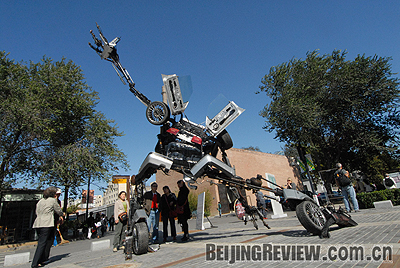|
|

CULTURE SHOCK: Beijing's 798 Art District is proof of the innovation and creative spirit emerging in China | Foreigners often misunderstand how China works. Let's look at education, for example: Many foreign teachers think that the Chinese education system inhibits creativity because it focuses on rote learning and memorization. I totally disagree. As an American who has gone through U.S. and Russian educational systems all the way through graduate school and beyond, I cannot criticize the discipline of memorizing information. To be knowledgeable, it is necessary to have an internal foundation of facts, as well as the ability to apply those facts to think creatively.
Today, in the Western postmodern era, the U.S. capitalistic system graduates students who are barely literate. They cannot tell anyone the names of all their own presidents, or where Guam is located, or even the name of the prime minister of the UK. In fact, in 2007 over 47 percent of the U.S. population was deemed illiterate. In contrast, 92 percent of the Chinese population is considered literate. Clearly, educational priorities of these two nations are not the same.
True, Chinese children invest much time learning to read and write their beautiful characters. This gives them not only an eye for aesthetics--writing Chinese characters is an art--but also a firm grasp of their own literary heritage. Teachers use poetry and the classics to impart literacy. Kids also receive a moral upbringing because education in China involves more than simple acquisition of knowledge: It is meant to teach young people how to live a proper life and get along with their fellow men. I have never been afraid to enter a Chinese classroom, but I cannot say the same of an American classroom. Perhaps, with the advent of Barack Obama, the U.S. education will improve.
Young Chinese also have a vast fund of knowledge to draw upon to stimulate their creativity. This is the country, after all, where porcelain, silk, paper, and a unique form of opera originated. The fact that China has only recently opened to the West might be a blessing: The unique Chinese perspective has not been jaded. Artistic outpouring has only yet begun, and the world's reception has been quite good. In 2007, Chinese painting started fetching high prices on the world market. Sotheby's sold a Xu Beihong's painting for $9.23 million, and Chen Yifei's painting: Eulogy of the Yellow River, sold for $5.27 million. Today the 798 Art District in Beijing is internationally known. Foreign artists flock there and Chinese art continues to dazzle the world.
Fashion and high tech are also enjoying unprecedented popularity. Beijing girls wear clothes that rival any Parisian. Vivienne Tam, Jimmy Choo and Shanghai Tang are a few names that resound in the West as well as the East. Beijing has its own homegrown Silicon Valley, with Lenovo winning many design awards, including the Japan G-Mark International Design Award, CHIP magazine's Annual Product Award at CEBIT, as well as the Hong Kong's Design Center's Best China Design Award.
China's creative designers are flexing their muscles. Developing winning ideas: from Haier's extra large 12 kg washing machine for Saudis, so that they can wash their voluminous robes, to designing fridges that double as study tables for Indian students, displays Chinese originality, combined with practical and innovative solutions.
Significantly, the Chinese are not afraid to cooperate with foreign designers. The company s.point design in Shanghai has created a water dispensing system that draws water from the atmosphere, using a membrane filtration system, eliminating the need for refilling. The Chinese founder and the German vice president cooperate and innovate, terming their firm as "a design company based in China." Their winning designs are cutting edge, reminiscent of the Bauhaus movement.
Contemporary Chinese music is also evolving. China's 3,000-year-old musical tradition has a distinctive sound, with gongs, cymbals and lutes (pipa), and high-pitched, nasal singing. Playing the guqin, a seven-stringed musical instrument, was one of the four scholarly arts in ancient China. Only in the last century did pianos and violins enter China, yet in recent years Lang Lang achieved international status as a classical pianist. Today's Chinese music combines and absorbs a wide musical range of understanding. Ceremonial, celebratory or avant-garde-the Chinese music scene deserves attention.
China is riding the wave of a creative renaissance. Five thousand years of culture is being accessed by young people experiencing modernization. These kids are expressing themselves in unique ways. The result is cutting edge, and going digital and going global. China is the place to be right now. |
